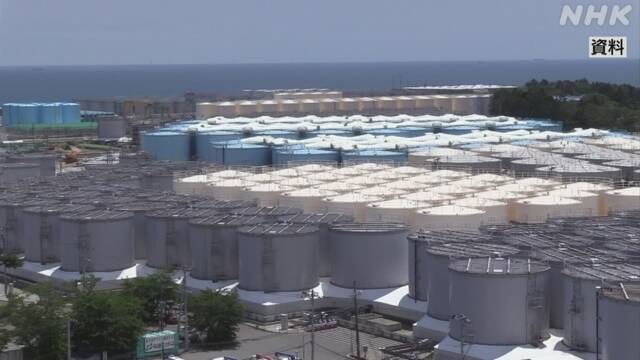Regarding the plan to dilute the treated water accumulated at TEPCO's Fukushima Daiichi Nuclear Power Station to a concentration below the standard and release it into the sea, an inspection team consisting of Korean experts will visit the site on June 23 to inspect the storage status of the treated water and the status of construction of facilities for discharge.
The Japan government plans to dilute the treated water containing tritium and other radioactive substances accumulated at the Fukushima Daiichi Nuclear Power Station to a concentration below the standard and release it into the sea, and TEPCO is preparing to start releasing it by around this summer.
The governments of Japan and South Korea agreed at a summit meeting held on May 7 to dispatch a South Korean inspection team to the site, and an inspection team consisting of about 30 people, including officials from the Korean Nuclear Safety Commission and marine environmental experts, visited the Japan on May 21.
The delegation will visit the Fukushima Daiichi Nuclear Power Plant for two days on June 23 and 24 to check the storage status of treated water, the results of analysis, and the status of equipment construction for the start of discharge.
There have been voices of concern in South Korea about the plan to dilute the treated water and release it into the sea, and the Japan will explain the safety of the plan and seek understanding through this visit.
On the other hand, the Korean government stated that the purpose of dispatching the inspection team was to "thoroughly confirm how it will affect the Korean sea and marine products, and immediately implement necessary measures."
Construction of facilities to be completed by the end of next month
At the Fukushima Daiichi Nuclear Power Plant, the amount of treated water containing radioactive substances such as tritium remaining after treating contaminated water continues to increase, reaching approximately 20.97 million tons, or 133% of the tank's capacity, as of March 1.
In accordance with the government's policy, TEPCO plans to add seawater to the treated water, dilute it to a concentration below the standard, and then discharge it into the sea from a point about 40 km offshore through a tunnel dug on the seabed.
The concentration of radioactive substances other than tritium is lowered below the standard level using a dedicated purification facility in advance for treated water. In addition, seawater is mixed to dilute the concentration of tritium to a concentration below 1,1 becquerels per liter, which is one-fortieth of the national standard.
TEPCO explained that the effects of radiation on people and the environment of releasing such water into the sea are small enough to be evaluated in accordance with international guidelines, and the Nuclear Regulation Authority considers this assessment to be reasonable. In addition, the government and TEPCO will continue to monitor seawater after the release begins to confirm that there is no abnormal increase in concentration.
At the Fukushima Daiichi Nuclear Power Plant, full-scale construction of the facilities used for the discharge began in August last year, and the excavation of an undersea tunnel was completed last month. TEPCO plans to complete the construction by the end of next month, and the government has indicated that it will start releasing the work by around this summer.
Release plan, safety concerns
Regarding the plan to dilute the treated water and release it into the sea, we are seeking understanding of safety both in Japan and overseas, but there are also concerns.
In Japan, all fisheries federations formed by fisheries cooperatives nationwide have consistently expressed their opposition, and there are deep-rooted local concerns, especially among fishermen, about reputational damage. In particular, with regard to the Fukushima Prefectural Federation of Fisheries, the government and TEPCO stated in a document in 2015 that they would not take any action without the understanding of the parties concerned, and the issue is whether they can gain their understanding.
Overseas, we requested the IAEA = International Atomic Energy Agency, and since last year we have been dispatching a survey team consisting of experts from countries such as China and South Korea, and the IAEA will publish the results of a comprehensive assessment before the start of the release by next month. In addition, the Leaders' Declaration announced at the G7 Hiroshima Summit held this month clearly stated that Japan supports the IAEA's assessment efforts.
China strongly opposes the Japan release plan, and Pacific island nations have also appealed that it should not be implemented until all parties concerned have proven its safety.
In South Korea, there is a deep-rooted concern about reputational damage to marine products among the people, and President Yoon Sung-yeol told IAEA Director-General Grossi in December last year that "the Korean people are worried," but at the Japan-ROK summit meeting held in Seoul on May 12, It was agreed to dispatch an inspection team made up of Korean experts to the site.

